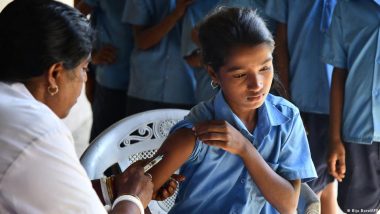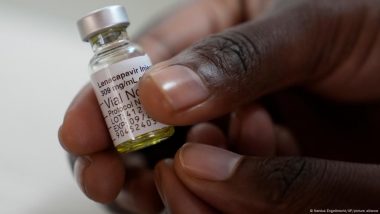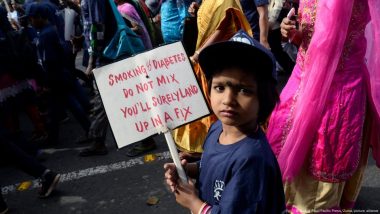The World Health Organization says low vaccination rates against measles mean more than half the world is at risk of outbreaks by the end of 2024.Measles has been in decline around the world since the 1980s. The World Health Organization (WHO) says that is largely due to vaccination programs, which — in the past 20 years alone — saved more than 50 million lives.
In the 1980s, there were as many as 4 million cases of measles per year. By the early 2020s, infection rates were down to a few hundred thousand.
Also Read | How Unhealthy Are Processed Foods?.
But measles is not gone yet. And the WHO says that that is largely due to people — especially children — not getting vaccinated: "Where children are unvaccinated, outbreaks occur."
On February 16, 2024, the European Centre for Disease Prevention and Control (ECDC) said measles vaccination rates have been "sub-optimal."
According to the ECDC, measles cases were expected to continue increasing in the European Union and European Economic Area in the coming months due to sub-optimal vaccination coverage for measles-containing vaccines (MCV).
The health authority also said there was a "high probability of importation [of measles] from areas experiencing high circulation and […] the coming months represent the seasonal peak of the virus."
"Nobody should die from measles. Vaccines are a safe and effective way to […] avoid unnecessary loss of life," said the ECDC’s Director, Andrea Ammon.
Decrease in vaccinations during the COVID-19 pandemic
Measles is highly-contagious and potentially deadly, but there is no specific treatment. So prevention through vaccination is seen as the best way to stop it spread.
But, then, the COVID-19 pandemic put a dent in those efforts, and we've seen a spike in cases as a result.
The US Centers for Disease Control and Prevention (CDC) writes that about 61 million doses of measles vaccine were postponed or missed during the first two years of the pandemic.
That tallies with other data from the WHO that states an estimated 128,000 people died due to measles in 2021, and most were unvaccinated or insufficiently vaccinated children under the age of 5 years.
What is measles and who is most at risk?
Measles is a disease caused by a virus that can cause pneumonia, diarrhea, deafness, blindness, brain damage, and in the worst cases death.
It is often described in combination with rubella and mumps because the illnesses they cause are similar. Children can also get a vaccine that protects against all three viral infections together.
Anyone can get infected with measles but children are most at risk.
The WHO says refugees are also at a particularly high risk of measles. Take, for instance, the Gaza Strip in the Palestinian Territory: The UN's International Children's Emergency Fund (UNICEF) has highlighted its concern about the spread of measles, as well as other preventable diseases like polio.
Nearly 19,000 children in Gaza — living among "1.9 million internally displaced people" — have missed routine vaccinations since October 2023 because of fighting in the region.
Measles outbreaks: Where is it spreading now?
In a joint report published in November 2023, the WHO and CDC said that deaths due to measles had risen by 40% that year.
John Vertefeuille, the director of the CDC's Global Immunization Division, described the increase as "staggering, but unfortunately, not unexpected given the declining vaccination rates we've seen in the past few years."
Its spread in 2023 led to epidemics in 37 countries and made 9 million children sick. The disease killed 136,00 people, mostly in poorer countries, said the WHO and CDC.
They are calling on health systems to ramp up their vaccination efforts, including in richer regions such as the United States and Europe.
In Europe, measles cases rose to more than 42,000 in 2023 — a 45-fold increase over the previous year.
How do you get infected with measles?
As with many other viral infections, a common route of "transmission" is via coughs and sneezes — "droplets."
But it can also spread in poorly ventilated rooms because the virus remains active and contagious in the air, and on surfaces, for up to two hours.
The WHO says the virus can spread from one infected person to a further nine out of 10 unvaccinated people, with whom the infected person has close contact. Vaccinated people are protected from the virus.
Symptoms are similar to those of a common cold — high fever, cough, runny nose — but are specially characterized by the appearance of a rash all over the body.
Prevention: The measles vaccine
The measles vaccine can be given alone, but is often combined with vaccines for mumps, rubella and/or varicella (chickenpox) — that's the so-called "MMR" jab.
The WHO recommends that children receive two doses of the vaccine to ensure immunity — two shots, irrespective of whether it's a measles-only vaccine or the combined MMR jab.
How is measles treated in patients?
There is no treatment for measles. But health experts say patients should rest, drink plenty of water to prevent dehydration, especially if they experience diarrhea or vomiting, and can take painkillers if required.
Doctors may also prescribe antibiotics to treat associated conditions, such as pneumonia, and ear and eye infections.
But since measles is a virus, antibiotics — which only fight bacterial infections — will not fight off a measles infection. And misuse of antibiotics is leading to growing antimicrobial resistance, rendering the drugs useless.
So, all you can do is let the virus run its course.
Edited by: Fred Schwaller
Editor's note: This article was originally published February 1, 2024, and was updated February 16, 2024, to include comments from the European Centre for Disease Prevention and Control (ECDC).
(The above story first appeared on LatestLY on Feb 21, 2024 02:00 PM IST. For more news and updates on politics, world, sports, entertainment and lifestyle, log on to our website latestly.com).













 Quickly
Quickly




















